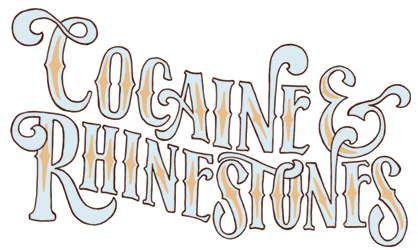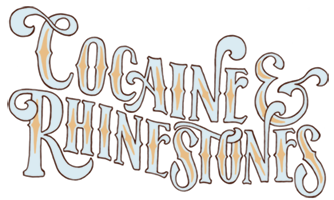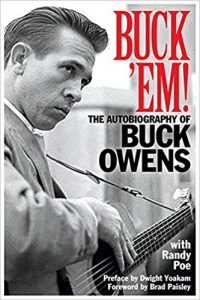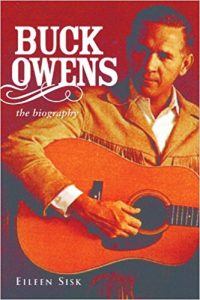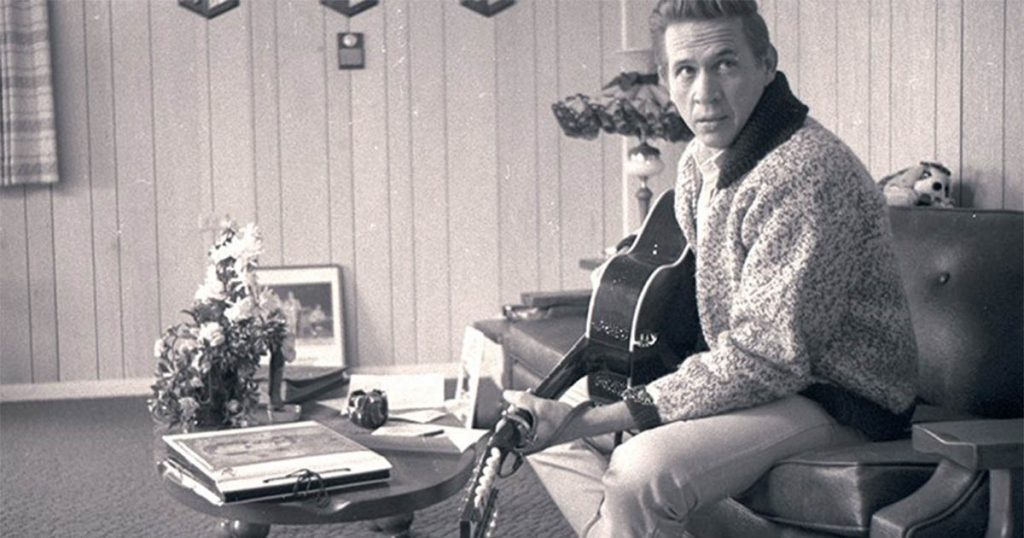
Buck Owens is an inkblot test. Ask 20 different people, get 20 different Bucks. Whatever else is true (and some of it certainly is), today we’re talking about the one who brought hard country music to the world in a time when we desperately needed someone to do that. Sticking to that honky tonk sound from Bakersfield made him a very famous man. Shrewd business practices made him a very rich man. Both of these things made him more than a few enemies.
However, all you need to take on the whole world is one true friend and Buck Owens had that friend in Don Rich, his guitarist and right-hand man. Here in the first part of this story, we’ll hear how everything came together, all those years ago…
This episode is recommended for fans of The Bakersfield Sound, Merle Haggard, Wynn Stewart, western swing and guitar.
Contents (Click/Tap to Scroll)
- Primary Sources – books, documentaries, etc.
- Transcript of Episode – for the readers
- Liner Notes – list of featured music, online sources, further commentary
Primary Sources
In addition to The Library, these books were used for this episode:
Transcript of Episode
Whose You Are You?
Probably most of you saw this commercial from a soap company in 2013. A forensic sketch artist with over 15 years experience at the San Jose Police Department is seated at a drawing desk where he and an interview subject can hear but not see each other. He asks the interview subject many questions about her own appearance and draws a sketch of this person, again, without seeing them. When he’s done, the interview subject leaves without seeing the sketch artist’s rendering of them. Another person, who’d met the original interview subject for the first time that day, is brought in and asked to describe that first person to the same sketch artist. Pretty much the same questions about the same person but the sketch artist is working from two different perspectives and ends up with two very different results. When sketching from a woman describing herself, he ends up with an image of a woman whose every self-perceived flaw and imperfection is on display. The sketches drawn from the perspective of strangers showed women with happier, friendlier features – a “nice chin,” a “cute nose,” “very nice blue eyes,” etc.
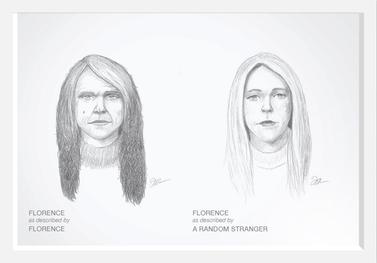
You could find a lot of flaws with this, if it were a science experiment, which it’s not. It’s only a real life demonstration of something they already knew was true before they started. The marketing agency who made this campaign was inspired to do so when market research indicated that only somewhere around 4% of women consider themselves beautiful. “Beauty is subjective. Real beauty is on the inside.” Yeah, yeah – all of that. But, if this is an accurate reflection of society, it means that out of every 100 women you see in your life, approximately 4 of them believe themselves to be beautiful. How many of them would you say are beautiful?
When Americans are asked to rate their own level of intelligence, 55% of them say they believe themselves to be of above average intelligence. We don’t even have to agree on a method for measuring average intelligence to know these people are not as smart as they think they are because 55% of any group cannot be above average. It’s mathematically impossible.
What I’m saying, I think, is that human beings are incredibly bad at judging ourselves, inside and out. We think we’re uglier than we are. We think we’re smarter than we are. We are good at rationalizing our own behavior where we would hold others accountable for doing the same things we do. Say you’re trying to not be late for work on the most important day of your life or say there’s a medical emergency. You make a decision to drive your car in an unsafe manner. You know why you did that and you cut yourself some slack for it. The guy you cut off in traffic would probably still be pissed even if he did know why you were driving that way but he doesn’t, so he’s extra pissed. He thinks you shouldn’t be allowed to drive a car, ever, at all.
Now, think about how many times you can remember seeing a random person drive like a maniac. That’s quite likely the only memory you will ever have of that random person in that random car. However, if a survey taker asked your opinion of that person you would be able to give one, even with the small amount of data that you have. Imagine if we were somehow able to take a poll of 10,000 random people you’ve had memorable interactions with – maybe not memorable to you but memorable to them – a totally random sample from your whole life. Your boyfriend or girlfriend might be in there, perhaps a best friend or two. But, also, maybe your ex-boyfriend or ex-girlfriend, maybe the guy whose taxi you stole on New Year’s Eve or the kid you were mean to in high school. What would the average “you” come out looking like? And, are “you” who you think you are? Or, are “you” who they think you are?
Should we put it to a vote?
Who the Buck Is He?
These are questions worth asking and thinking about before we start talking about Buck Owens. This is a guy who- well, it really depends who you ask. While many people think of Buck Owens as the human definition of “country music,” others demonize him like some kind of Boogeyman in Bakersfield. There’s no arguing about the fact that Buck Owens gave real country music a much-needed shot in the arm when Nashville was whoring itself out to pop audiences. Buck was the ambassador of Bakersfield, California’s honky tonk sound; he brought it to America and he brought country music, in general, to the rest of the world as nobody had ever done before, establishing a multi-million dollar business empire in the process. I’m not sure it’s possible to do that without making some enemies and you’ll never find anyone who will tell you that Buck Owens was some kind of saint.
We’ll talk more about all of that but what I’m more interested in is the relationship and the contrast between Buck Owens and his best friend and secret weapon, Don Rich. If you’ve seen old footage of Buck playing on TV then you almost definitely saw Don Rich, too. He was the guy playing a Fender Telecaster guitar just the way it’s supposed to be played, coming in high and tight on those harmony vocals.
This is part one of a two-part series on Buck Owens and Don Rich. Today, we’ll talk more about Buck.
Going from his childhood into the music scene of Bakersfield, we’ll hear how he climbed from working as a session guitarist up to dominating mainstream country music from 2,000 miles outside of the establishment…
Buck Owens would let you believe his childhood was that of a sharecroppers’ son, much like that of Ernest Tubb. But he’s always wearing pretty nice clothes in the pictures of him as a child, his dad usually had good jobs and Buck’s own stories of all the instruments his parents were able to buy for him suggest that he could be playing up the poverty, a little. First, it’s a mandolin, then a guitar, then a steel guitar – he learned to play them all but it was his electric guitar playing that put him on the map in Bakersfield.

Here’s what you need to know…
Buck Owens was born in 1929, in Sherman, Texas. That’s pretty close to the Oklahoma border but, even if it wasn’t, they’d have still been called Okies had the family made it all the way to California in 1937. Their trailer hitch broke in Arizona and that’s where they stayed. In Arizona, he came down with something they called “brain fever,” possibly what we’d call meningitis today. Whatever it was, it caused him to have a stroke at the age of nine or ten. They put him in the hospital for close to two months. That stroke made him temporarily forget how to read and write, even his own name. It all came back to him but Buck says he had slight hearing loss for the rest of his life and wasn’t able to run as fast as he could before the stroke. There’s no telling what other physical mannerisms or personality traits could be attributed to that stroke.
Did he nickname himself “Buck” after the family’s mule?
Yes.
Did he drop out of high school because he had to work to help support his family?
According to him, yes. According to his mother, no.
Buck started hanging around honky tonks way before he was old enough to go inside of them. That was the only place you could go to hear good country music, though. He’d post up outside the back door and listen to the bands. Because he hit puberty early and was unusually tall for his age, he was playing on those stages himself soon enough. Buck’s problem with women started around the same time.
Buck’s problem with women was that he could never get enough of ‘em, even he had two or three who thought they were the only one in his life. At any point in this story, just assume that Buck Owens is sleeping with any woman that he can because we really don’t have time to keep track of the details. But we do have to talk about Bonnie Owens. Buck meets Bonnie in Arizona. They’re the same age, Buck thinks she’s the prettiest girl around and they start going steady. However, Buck is also under the impression that a guy doesn’t have “sexual encounters” with his main girl. He says everyone knows you’re not supposed to have sex with the girl you plan to marry until you marry her. That’s what other girls are for…
Bonnie catches Buck making time with other girls. It becomes an on-again/off-again sort of thing between them. One time, when it’s off-again, they both show up to the same audition for a tiny radio station gig. This is how Buck finds out Bonnie has plans to become a country singer, which is, of course, what she goes on to do. When Buck’s 18th birthday rolls around, it’s apparently on-again, because Bonnie gives him one hell of a present and soon discovers she’s pregnant. They get married. Family life doesn’t change Buck at all. He stays focused on work, playing music and chasing ladies when he can. Bonnie has another baby. When Buck’s Uncle Vernon in Bakersfield mentions how great their local music scene is, Bonnie goes ahead and moves there with the kids. Buck stays in Arizona for a while longer. The whole marriage thing? Doesn’t seem to be working out. Even after Buck moves to Bakersfield, too, he lives in his car rather than moving in with Bonnie and the kids or any of his other family in the area.
This is probably the poorest Buck ever was in his life. By the time Buck meets a musician named Dusty Rhodes, who invites him to audition for a steady paying gig, he’s already had to pawn his guitar. He goes down there anyway, borrows a guitar from someone else in the band and shows everyone what he can do. They like his playing so much that everyone agrees to take a pay cut in order to hire him.
Now, the best advice Buck ever got from his father was, when you have a job you get there ahead of starting time and, if there’s something that needs to be done, you be the first to volunteer. That’s his approach to accomplishing goals. His goal at this time is to become the best guitar player in the world. Bakersfield, California, in 1951, is the perfect place to be for anyone with that goal. He starts making decent enough money to get his own place and move Bonnie and the kids in with him. Though, that just makes it more obvious that the marriage is doomed and they soon split for good, leaving Buck to focus exclusively on music.
The Stages of Bakersfield
Whatever music in California sounded like before The Great Depression, millions of okies showed up and changed all of that by bringing their music with them. For an example, you can listen to Woody Guthrie’s cousin, Jack Guthrie, doing a song in 1947, called “Oakie Boogie.” After rock and roll becomes a thing, a bunch of people will look back at “Oakie Boogie” and say, “Oh, that was rock and roll before rock and roll.” At the time, they just call it Western Swing. Bob Wills & The Texas Playboys moved to Los Angeles in 1943, then Fresno around 1945, then opened a nightclub in Sacramento for a couple of years around 1947. The Texas Playboys toured the area and did live radio broadcasts from the Beardsley Ballroom in Bakersfield.
So, Buck Owens has arrived in a California where Western Swing is just as big, if not bigger, than where he came from. In Bakersfield, if the crowd isn’t dancing, you’re doing something wrong. The dancing crowds want to hear other styles of music, too, though. There’s a mixture of musical genres here that eventually results in something we call The Bakersfield Sound.
The best band in town is The Orange Blossom Playboys. They have business cards made up promoting their shows at the most popular nightclub in town, The Blackboard. In addition to Western Swing, these cards advertise that the band plays country music, rhythm and blues, rhumba, pop and polka. After they see him playing with that first band, Buck is offered more money to join The Orange Blossom Playboys at The Blackboard. Of all the genres they play, it’s the “Country & Western” material he enjoys the most.
In the early ’50s, this Country & Western classification is still pretty new. The type of country music being mixed with Western Swing in California is hardcore honky tonk. Hank Williams was the biggest thing on the Grand Ole Opry up until 1952. Ralph Mooney is already playing pedal steel with Wynn Stewart. Roy Nichols has already played guitar for The Maddox Brothers with Rose, is currently with Lefty Frizzell and, in 1955, he’ll begin a five year stretch in the house band on Cousin Herb Henson’s Trading Post Gang. That’s the local country music TV show everybody watches on weekdays, just before the news. All of these musicians are huge influences on Buck Owens. In the final episode of Cocaine and Rhinestones’ first season, which will be about Ralph Mooney, I’ll be talking a lot more about Buck’s influences, The Bakersfield Sound and where The Bakersfield Sound came from. Buck Owens is, without question, responsible for a very, very big part of it. You can hear Buck playing lead guitar on what many people consider the first record with The Bakersfield Sound on it, Bud Hobbs’ “Louisiana Swing,” recorded in 1954. Buck began doing studio work in ’53 with Tommy Collins’ first session at Capitol Records. Nothing came of that but, the second time around, Tommy got his first and biggest hit with “You’d Better Not Do That.” Buck’s guitar was a big part of the song, which is one reason why the producer on that session – our old friend, Ken Nelson – starts using Buck as his go-to guitar guy in California.

Buck Owens, Jelly Sanders & Tommy Collins
Capitol’s recording studio is in that famous Capitol Records building you’ve seen in every movie with a shot of Los Angeles. Buck drives down there from Bakersfield for the extra work. After a session, he’ll drive back up to play at The Blackboard. Studio in the day, onstage at night. Studio in the day, onstage at night. You’ve heard the saying “practice makes perfect”? Performance makes more perfect. Buck was a great guitar player when he came to Bakersfield. Spending all day and all night working with the best musicians around turns him into an incredible guitarist. Now, The Orange Blossom Playboys are the house band at The Blackboard. That means they play regular sets all through the week but, also, if a national touring act comes through without a full band then The Orange Blossom Playboys back them up, too. So we’re talking hours and hours of playing guitar, here, pretty much every day – always learning new material, getting good at improvisation and short-notice composition. When the band’s main singer takes off, Buck gets moved in front of the microphone.
The leader of The Orange Blossom Playboys is a guy named Bill Woods. Today, he’s known as The Father of the Bakersfield Sound because of how much he did for all these musicians. He’s a musician, too – he started out with Bob Wills and the Texas Playboys – but his real contribution to this scene is more as a coach than a player. If this was all happening in a recording studio instead of in nightclubs, Bill Woods would be the producer. The Blackboard is a honky tonk, though – always full of drunk crowds, who are rowdy and loud. After Buck gets put in front of the microphone, Bill Woods moves all the songs up a half step or two, pushing Buck to sing at the upper limits of his range, giving his performing style a heightened sense of urgency to match the vibe of the room. The other thing about The Blackboard is they don’t have stage monitors for the band. Buck (who, remember, has hearing loss from that stroke when he was a child) can only hear himself singing in the out front sound system and only if he sings loud. Joe Maphis tells Buck they’re the loudest band he’s ever played with. As it happens, one night in 1952, Joe and Rose Lee wrote “Dim Lights, Thick Smoke (And Loud, Loud Music)” after playing with The Orange Blossom Playboys at The Blackboard.
The Art of the Deal
So, that’s the situation for Buck Owens in 1954. He’s got the most high profile band gig in a big music town and the main country producer at Capitol Records wants him on every session. Then, Terry Fell plays a show at The Blackboard. You know Terry’s song, “Truck Drivin’ Man,” because it’s been recorded by… everyone. Well, Terry’s pretty impressed by Buck Owens. He says he can get Buck a record deal, if he’s got any songs he’s written. Buck starts writing songs pretty damn fast so he can take Terry up on the offer. Then, the label Terry had in mind decides they’re not doing country music anymore so the deal falls through. Terry must feel bad about that because, a little while later, he invites Buck out to meet the owner of a very small label, named Pep Records. The first Buck Owens single is released on Pep Records in 1956. The a-side, “Down on the Corner of Love,” is hard evidence that Buck Owens knew exactly what Buck Owens records were supposed to sound like, right from the beginning. Only, Pep Records is such a small operation they can barely get records pressed, let alone distribute and promote them. The single doesn’t do much but the song is covered by other artists with major label deals, like Red Sovine and Bobby Bare, so Buck knows he’s doing something right.
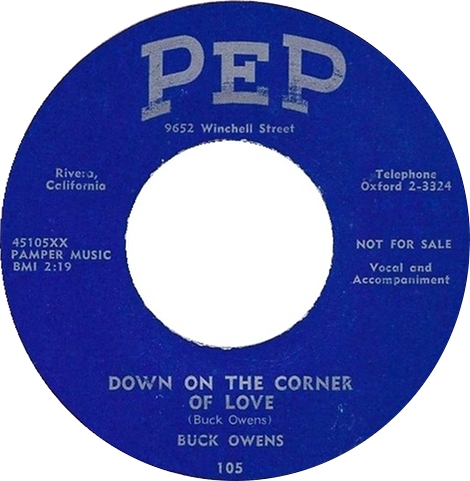
Meanwhile, back at the Blackboard, that bandleader, Bill Woods, decides to open up his own nightclub and take The Orange Blossom Playboys over there. The owner of The Blackboard offers his stage to Buck. So, move across town and stay in Bill Wood’s band or stay put and get his name on the sign out front. Buck Owens and His Schoolhouse Playboys are the new house band at The Blackboard.
Now, the owner of Pep Records knows he’s not doing Buck any favors by keeping him on the label. It’s barely even a label. Really, it’s just this one guy, Claude Caviness. Claude takes that one Buck Owens single into Ken Nelson at Capitol Records. Either Ken doesn’t think it’s that good or he doesn’t want to lose his best studio guitarist because he gives it a hard pass. Terry Fell hits Ken up about it, too. Ken gives Terry the same answer. Buck may not know about any of this because, while all that’s going on, Buck’s making moves towards an artist deal with Columbia Records. And he’s making those moves on the downlow because he doesn’t want to lose any session work at Capitol from them finding out about it.
In February of 1957, a local act, called The Farmer Boys, stops by Buck’s house. They’ve got studio time booked at Capitol in a few days, Buck’s already scheduled to play guitar for them and they came over to see if he’s got any songs they can record. Of course, Buck’s been writing on his own and with friends, like Rollie Weber, Dusty Rhodes and Red Simpson. The Farmer Boys pick out four they like and tell Buck they’ll see him at the session in a few days. One of the songs they pick is one Buck wrote all on his own, called “Yearning Burning Heart.” That one will sound real familiar to hardcore Buck Owens fans, even if you haven’t heard it, because it’s the same melody Buck used on his final single for Pep Records the year before, “There Goes My Love.”
Anyway, the standard goal for a three-hour recording session is to get four songs down, so Buck’s feeling pretty good about the day’s work before he even walks in the building. If any of the songs they record that day make any money at all, Buck’s getting some of that money as a writer, on top of whatever he makes for working the session. Good deal. Except Ken Nelson is not happy to see Buck Owens walk in. Ken had already picked out what he wanted the Farmer Boys to record that day. Buck unknowingly screwed that all up by giving them these four songs. Oh well, they get to work.
First song in the can, Ken’s voice comes over the studio monitor, asking for the name of the songwriter and publishing company so he can write it on the tape. Buck wrote it and he’s not with a publishing company. Same thing after the second song. Ken calls a break and takes Buck somewhere to talk in private. He comes at him with one of those, “You know… you’ve been working hard around here a while and I think it’s maybe time that Capitol gives ol’ Buck a chance to see what he can do on his own…” He offers up an artist contract, right there. Buck comes clean about talking to Columbia Records, telling Ken how Don Law himself is supposed to be coming out to L.A. any day now to sign him. Well, now that Ken knows Capitol Records isn’t the only girl Buck’s thinking about taking to the prom, he comes on even harder. Buck asks if he can have some time to think it over. Anyway, they’ve got to get back in the room and cut those other two songs.
After the fourth time they run through that “who’s the writer? who’s the publisher?” act, Ken finally tells Buck he ought to put the songs with Central Songs’ publishing. Naturally, it later comes out that Ken Nelson is secretly part owner of Central Songs’ publishing. It’s not a stretch to imagine whatever four songs he wanted The Farmer Boys to record were probably in the Central Songs catalog. You could imagine him sitting in that control room, thinking about his session guitarist cashing royalty checks for that day’s work, trying to think of how to get back in on that action. After selling Buck on using Central Songs as a publisher, Ken brings him up to his fancy office on the 12th floor and puts a real live recording contract on the table. Ken tells him to sign the papers. Buck signs.
So, this is a really big day for Buck Owens. The main writer on every song in a session, walking out of the building with a publishing deal and a record deal – but the most valuable thing he gets that day is a lesson in Old School Record Business 101. While it does take some time for the information to come to light, once Buck later finds out that Ken Nelson is part owner of Central Songs, all the events of this day click into place. He sees the entire game. It’s all about ownership and contracts – that’s how you win. While all these singers and musicians are running around in rhinestone suits trying to get famous, the business suits up in the office building are getting rich as shit by owning as much of the machine as possible and the artists are giving it to them by signing these contracts. Sure, they loan you some money for signing the papers but you’ve got to make all that money back for the label before you see any more cash. Then they own the master tapes of your music forever because they fronted the money or the studio for the recording sessions. Throw in a piece of the publishing and that’s multiple ways a person not named “Buck Owens” is making money off Buck’s record sales, possibly even more money than he’ll make!
Well, if you can’t beat ‘em, join ‘em. Nearly every single person who has something bad to say about Buck Owens signed a contract with him. Were any of those contracts unethical? I have no idea. I haven’t read them. But that’s what lawyers are for. Has the music business in general always been unethical? That’s funny.
But we’re still back in 1957. Nobody’s really mad at Buck yet.
Bill Woods isn’t even mad at Buck for staying at The Blackboard and starting his own band. Because, that nightclub Bill started? It ends up failing and here come The Orange Blossom Playboys, back to The Blackboard. Bill offers Buck his old job back. I mean, really, Buck would have reason to be angry about this. If that honky tonk they tried to start couldn’t stay open, it was probably because the crowds stayed at The Blackboard with Buck. We’re talking a baby Buck Owens, here – just killing onstage, close enough for you to reach out and touch him, wet ink on a deal with Capitol Records. No offense to Bill Woods, you give me a time machine? I’m watching Buck Owens. Who wouldn’t want to see that? Anyway, Buck takes the demotion.
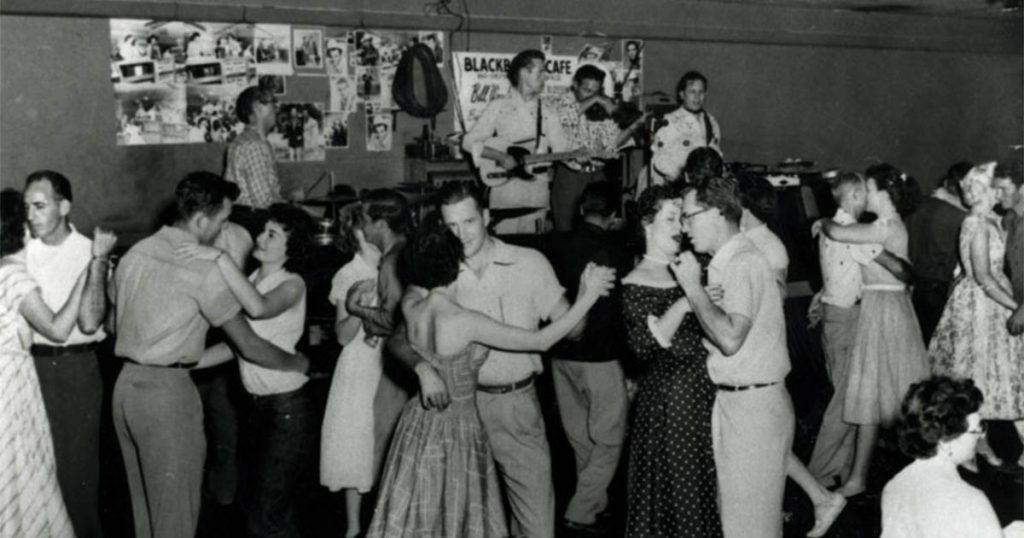
He’s jamming with Wynn Stewart and Harlan Howard way before anyone cares about either of those names. Harlan even starts coming to Bakersfield to write songs with Buck, who isn’t called in to record for Capitol until six months after his contract signing. When you see a Ken Nelson interview somewhere, you’re going to see him talk about how he takes a very “hands off” approach as a producer, letting the artist do what they want and only pointing out if something doesn’t technically sound right, like an out of tune instrument. Well, if you heard The Louvin Brothers’ episode of Cocaine & Rhinestones, then you know that’s not exactly true…
On those early records, the producer had insisted on including all these damn background vocals – lots of guys and gals singing ‘oohs’ and ‘aahs’ under my stone country vocals. It sounded ridiculous. As a matter of fact, those singles came out sounding a whole lot like the kind of stuff they were recording in Nashville back in those days – and the last thing I wanted was for my records to sound like those pop-country things they were doing down there.” – Buck Owens
You can hear exactly what he’s talking about on his first single for Capitol, “Come Back.” And, if you remember what his singles on Pep Records sounded like? Yeah, this has “Ken Nelson” written all over it. The second Buck Owens single Capitol puts out has even more background vocals than the first and, this time, they’re louder in the mix. Buck wrote the song with Harlan Howard. It’s called “Sweet Thing” and it sounds more like Memphis than Nashville to me but, either way, these records do not sell.
Then, Buck gets a phone call from his old pal, Dusty Rhodes, that musician who took him to his first audition in Bakersfield. It’s a good phone call.
On the Same Wavelength
Dusty’s up in Tacoma, Washington. He’s been working with a guy who just bought a small radio station. If Buck goes up there, he can become part-owner of this station by making cold calls to sell ad spots. They said the magic word: ownership. He moves up there and finds out he’ll have to DJ, too, but that’s so much fun, he doesn’t even mind that it pays nothing. Plus, there are a few places with good stages in the area where he and Dusty can play and he gives himself free advertising on air.
Buck goes from bringing in $80 a week at The Blackboard to $500 – $600 a week in Washington. That’s a huge jump in salary but, when Dusty shows up all excited one day about the fiddle player he’s found, Buck’s not trying to make less money so they can pay some other musician. Dusty convinces him to at least listen to the kid first and it’s a good thing he does. Don Ulrich is 16 years old when he meets a 28 year-old Buck Owens, who pretty much immediately changes Don’s last name to “Rich” for the stage. Oh, and, yeah, he’s hired. The kid can play. He’s so good, Buck doesn’t mind personally driving 30 miles each way to pick the kid up for rehearsal. Don has a driver’s license but his Mom won’t let him drive anywhere alone.

After a few months up in Washington, making serious money at the radio station, playing music his way with Dusty and Don, Buck writes Ken Nelson a letter. It says he can’t make the kind of music Ken wants him to make and Capitol should let him do what he wants to do, if they want him to stay. Otherwise, it would be best to tear up the contract and move on, in separate directions. Ken flips the letter over and writes on the back: Dear Buck, we still want you. We believe you have talent. We’re sticking with you.”
So, Buck drives down to Los Angeles. He’s in charge of the recording session this time and he’s got Ralph Mooney on steel guitar. They get four songs in three hours. Buck’s favorite is called “Second Fiddle.” In 1958, Capitol Records… puts out a different song. Nothing happens.
Back in Tacoma, the band figures out they can play live on-air if they set up in a large TV studio down the road and use a phone line to send the audio signal to the little radio station. And, since they’re going to be set up in a TV studio anyway, they may as well pitch the station manager on giving them a show. It works. The TV signal broadcasts much farther than the radio station. They’re getting more shows with bigger audiences and better money. They even talk little Don’s super-protective mom into letting him go on the odd overnight trip.
She isn’t his biological mother; Don was adopted by the Ulriches. He didn’t know who his parents were. A woman who became very close to Don says this always bothered him. He thought his real mother and father didn’t want him. The Ulriches, though maybe a little clingy, are great. His dad’s a music lover and made a tiny little fiddle for two year-old Don. Music lessons stayed mandatory in the home. Sports were not allowed because Don might hurt his hands and damage his playing ability.
Here, at 16 years old, Don’s already good looking and very talented. He plays fiddle like a total pro and, when Buck lets him sing a song or two, it always drives the girls crazy. The girls are interested in Don but his mom is just too much for anyone to handle. Traveling around to play shows with Buck and Dusty and the other guys gives Don some much-needed breathing room. Girls in other towns don’t know he’s got a helicopter mom. They pay Don plenty of attention.
Of course, you get a lot of attention from the guys in the band when you’re on the road, too. Buck remembers the very first road trip that required getting hotel rooms. Dusty and Buck get one room and the rest of the band are in another room, next door. Buck hears all this commotion after everybody’s gone to bed, opens up the connecting door and asks what the hell’s going on in there. Don’s got his back against the wall. Looks terrified. He tells Buck he heard the other guys talking about drawing straws to see which one of them was going to get first crack at Don. Buck somehow manages to keep a straight face. He tells them not to forget that whoever draws the shortest straw has to sleep on the floor. You know, maybe Don’s mom was right to be so protective…
Something I haven’t told you yet is Don was performing on the radio when he was five years old, playing guitar by the age of eight and already causing some fuss in various jazz, rock and country bands in the area when Dusty Rhodes “discovered” him. It’s pretty possible “Don Rich” would be a name worth talking about had he never met Buck Owens. Although, he wouldn’t have that name without Buck Owens and, once he played music with Buck, it was never the same with anyone else.
So, “Second Fiddle,” that song Buck liked best from the last Capitol recording session? The record company waits until 1959 to put that out as a single. When they finally do, it hits the country charts and goes to #24. Capitol Records wants him back in the studio as soon as possible. One more road trip, four more songs in the can. This time, they get down a Buck Owens-Dusty Rhodes composition, called “Under Your Spell Again.” That’s the single and it goes to #4, while Ray Price’s cover of it goes to #5. Buck gets paid royalties on both versions of the hit. And he doesn’t know it yet but, from right here in 1959 until 1975, any Buck Owens single that doesn’t crack the Top 20 will be an outlier.
The next time they record in L.A., Don goes down there with them. On the way, in the car, Buck’s practicing his material and Don starts singing perfect harmony with him, which isn’t something they’ve done before, not something they’ve practiced. According to Buck, from that very first time, it was like they’d been singing together forever, like Don could read Buck’s mind. It sounds amazing. Still, Buck does his own harmonies on the session. He’s not sure yet if Don can pull that off under pressure. This one trip to Capitol nets two more Top Five singles, so Buck decides it’s time for him to move back to California and really get to work. But Don had begun taking classes at a community college a few months before this. Even though he’s a legal adult at the age of 18, when Buck asks him to move to California, Don knows his mom will totally lose it if he quits college. As much as he loves playing and singing with Don, Buck can not put his career on hold while the kid gets an education. He’s got to strike while the iron’s hot. They part ways.
Going Back to Cali
Only, four months after Buck returns to California, he’s got a letter from Don in the mail. The letter says how much Don hates college and it’s just not gonna work out for him. The people he’s playing music with now don’t do it the way Don likes it. Don likes the way he and Buck played music and he wants to know, if he comes to California, would Buck still have a job for him? In the letter, the word “job” is spelled j-o-b-b. Buck calls him on the phone to agree, yeah, it doesn’t look like college is for Don Rich so he’d better get his ass on down to California and they can start playing music again the way they both like it.
Don moves to Bakersfield, into Buck’s house. Although, not before going missing for a few days with his girlfriend, Marlane. Don’s mom just about dies from worry and wears Buck out, ringing his phone off the hook. Don does finally show up and it’s all good. They head out on the road, just the two of them in a car with a 4X10 Fender Bassman amp they both plug in to, playing with honky tonk house bands all over California. This is the period of time when, like a little sponge, Don Rich completely absorbs Buck Owens’ guitar playing style.
Don moved to California in December of 1960. Within a year, he goes from being the fiddle player to, you look over there and he’s got a guitar in his hands again. By March, he’s playing guitar on recording sessions. It’s not just that Don can play guitar. It’s that he can do it exactly like Buck Owens, who, let’s not forget, is great at guitar. Don Rich and Buck Owens pulling twin leads on Telecasters? This becomes a thing pretty quickly. Don takes the Buck Owens approach to guitar and runs with it. To a lot of people, country guitar playing doesn’t get any better than Don Rich and Buck Owens.
In 1963, Buck hires two more musicians for the road. Jay McDonald on steel, because he can kind of get close to what Ralph Mooney’s been doing on Buck’s sessions. And a dude on drums, named Moose, because how do you not hire a dude on drums named Moose? Moose provides plenty of entertainment, on stage and off, even if he does almost get everyone arrested on multiple occasions.
You remember how Buck loves a good time with the ladies and everyone else besides Buck likes to drink. So, anytime they’re close to the Mexican border, they hop over there for a party. Buck always reminds everyone to not take anything illegal over there or bring anything illegal back. Well, one time, this border guard tells them all to empty their pockets on the counter. A single white cross falls out of Moose’s pocket and rolls all the way down the countertop, stopping right in front of where Buck’s standing. Everyone watched it roll the whole way down there. When it stops, Buck just picks it up and puts it in his pocket. For whatever reason, that border guard lets them all go. He must have been looking for a lot more than one little pill. And those white crosses do come in pretty handy with all the driving…
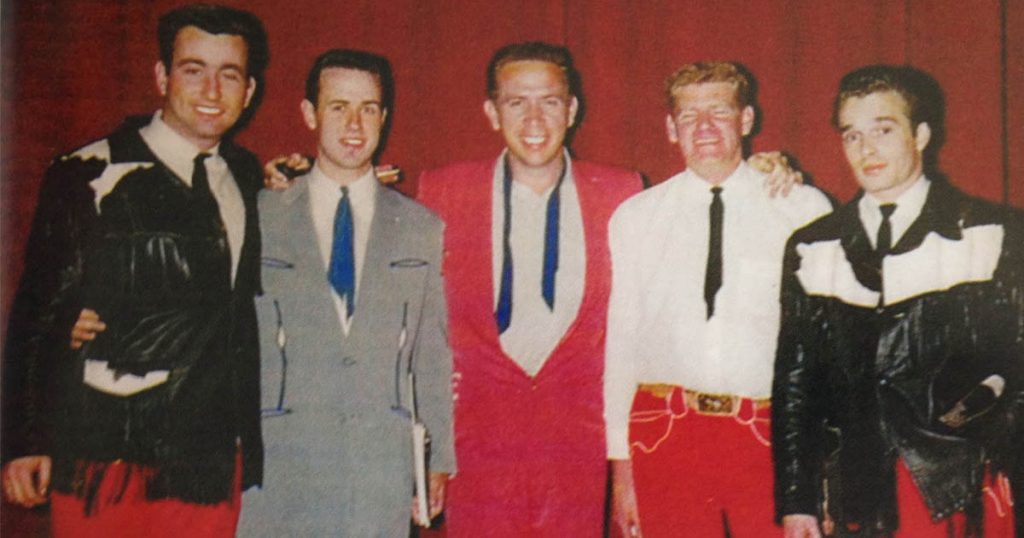
Moose, Don, Buck, Jay McDonald & Merle Haggard
Buck’s got this pickup truck with a camper on the back. That’s what they’re touring in when Merle Haggard comes on board to play bass for two or three weeks. One day, Moose gets too excited, talking about Elizabeth Taylor while he’s driving. His steering goes a little squirrelly and, next thing you know, they’re being pulled over by a cop. That police officer drags everyone out on the side of the road. He’s going through their stuff, giving everyone a hard time, when he finds Moose’s bottle of pills. He goes up to Merle and asks what it is. Merle tells him, “That’s Moose’s medicine, officer.”
‘Moose medicine?! Never heard of such a thing! Okay, everybody back in the camper – y’all get outta here!”
Now, just a few years before this, Merle Haggard was in San Quentin, so he doesn’t hang around much longer. But he is around long enough to tell Buck he ought to name his band The Buckaroos. (We’ll check back in with Merle Haggard next week.) Somewhere in 1964, what everyone thinks of as the classic Buckaroos lineup falls into place. Of course, there’s Don Rich on lead guitar/occasional fiddle/official right hand man duties, Tom Brumley on pedal steel guitar, Willie Cantu on drums and Doyle Holly on bass. But we’ve got to back up a bit to talk about Buck’s first #1 record, “Act Naturally,” because Don is the only one of these guys who played on it.
Hitting the Big Time
Okay, there are several different versions of how this happened, so here we go.
100%, for sure, Johnny Russell wrote the song. He and Voni Morrison were song pluggers. (If you don’t know what that is, check out the Tom T. Hall episode of Cocaine & Rhinestones.) Johnny and Voni had a deal worked out to include each other’s material in plugging sessions and share songwriting credit on all of it. So, today, you’ll see Voni Morrison listed as a writer and she made a ton of money from the song but Johnny Russell wrote it.
Now, Buck Owens says he loved this song as soon as he heard the first line and knew he wanted to record it, right away. Only, Johnny Russell says Voni Morrison told him, Buck Owens liked “Act Naturally” the least of everything she played for him that day. Some people who were around say Don Rich was the one who fell in love with the song. He kept walking around, humming it all the time, until Buck eventually figured if Don liked it that much, he’d better record this damn song. It comes out in March of 1963, #1 country song by September. In 1965, The Beatles record the song and take it to Top 40 radio.
Nearly every Buck Owens single for the next ten years goes #1 country. Over twenty #1 songs and one of them is the b-side of another one…
Maybe the best indication of Buck Owens’ greatness in the ’60s is that “Together Again” gets released as the b-side on one of his records. The a-side of that record is “My Heart Skips a Beat.” Great song. Three weeks at #1. The b-side just happens to be one of the greatest country music performances ever captured in a recording studio.
It’s possible that “Together Again” sold more pedal steel guitars than any other song of the 1960s. Tom Brumley lays down a solo over the entire track that sounds like a kicked hound dog crying. It sounds plain miserable in a way only the best country music can. It’s one reason many people are surprised when they get around to hearing the lyrics and realize this is a love song. As effective as Tom Brumley’s work is (and Buck Owens would later say “Together Again” set the standard for steel guitar players everywhere), it’s only one piece of what makes this song what it is. Every element of this performance rains misery down on us, from the drums and rhythm guitar that sound like they’re on quaaludes to Buck’s stabbed-in-the-back sincere vocal delivery. So, why are the words all happy?
Because “Together Again” is the opposite of that cliched “man with nothing who has nothing to lose.” The singer of “Together Again” has love, the best thing anyone can have, so now that’s what he’s got to lose and they’re together again, so he already knows what it feels like to lose it. And he knows he’ll lose it. There’s no tragedy or divorce or death in the song but everyone knows “happily ever after” isn’t a real thing. “Together Again” tells us there are no happy endings without even having to tell us the ending. That’s the true genius of this song and a big lesson for anyone who believes a song that spells everything out is automatically sadder than any song that doesn’t.
So, not only does Buck Owens release two #1 songs on opposite sides of a record but check this out…
“My Heart Skips a Beat” stays at #1 for three weeks. “Together Again” replaces “My Heart Skips a Beat” at #1 for two weeks. Then, “My Heart Skips a Beat” goes back over “Together Again” for four more weeks at #1. As far as I know, this is the only time the #1 position on country charts has been consecutively held by the a-side, b-side, then a-side again of one record.
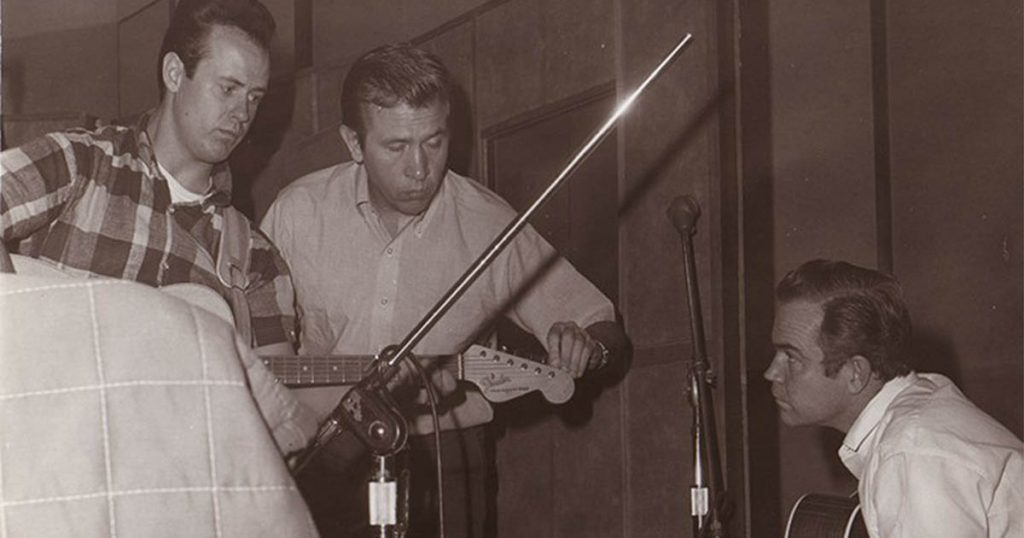
Don, Buck & Red Simpson in the studio
By the way, the fan favorite Buckaroos lineup is still not assembled at this point. Mel Taylor of The Ventures plays drums on this recording session while a 17 year-old Willie Cantu is en route to California to join the band. Go back to add in “Love’s Gonna Live Here” and Buck Owens has four #1 singles under his belt before the best version of his band even comes together.
We’re now in 1964. By the end of the year, Buck will put out his biggest commercial hit ever, “Tiger by the Tail.” It goes #1 country, which is honestly just what you expect from Buck Owens by now, but, also, #25 pop. You can spend weeks, and weeks at #1 on the country chart but that’s nothing compared to what happens when you crack the pop Top 40. Before “Tiger by the Tail,” everyone who listens to country radio knows who Buck Owens is. When “Tiger by the Tail” hits Top 40 radio, everyone waiting to hear the new song by The Beatles or The Kinks or The Temptations or The Supremes, all these people hear Buck Owens for the first time. It’s like the difference between being the best player on a high school basketball team and being any member of the starting lineup in the NBA.
Yet, somehow, word doesn’t seem to be spreading to Nashville come award season. Music City USA likes to think of themselves as the “hitmakers” and the “deciders” when it comes to country music. While they’ve been watering down country music for close to a decade with The Nashville Sound, getting rid of those twangy old-timey instruments, pumping everything full of huge string sections and bending over backwards for that pop crossover success – here comes Buck Owens, sounding like he just walked out of a wheat field with a steel guitar under one arm and a fiddle under the other. And, there he is on the pop charts, smiling down on at least half the pop bullshit that came out of Nashville that year. The establishment doesn’t know how to deal with this guy. They do their best to ignore him, which is difficult to do when Buck’s doing things like taking out a full page ad in Nashville’s Music City News with a sketch of himself and a Pledge to Country Music, reading:
I shall sing no song that is not a country song. I shall make no record that is not a country record. I refuse to be known as anything but a country singer. I am proud to be associated with country music. Country music and country music fans have made me what I am today. And I shall not forget it. –Buck Owens
The message was loud and clear. Nashville may have forgotten where it came from but Buck Owens hadn’t. It takes decades for the Nashville establishment to acknowledge Buck Owens’ contribution to country music. Awards shows have always been a joke and, if you want a prime example of why, you need look no further than the fact that Buck Owens has never been given one, single award by the Country Music Association and he was only ever nominated for five. Buck Owens wasn’t inducted into the Country Music Hall of Fame until 1996, over 30 years after his Pledge to Country Music in 1965.
And that’s where we still are, 1965. For the next ten years, whatever else is happening in this story, it’s happening while Buck Owens and The Buckaroos are touring their asses off. Nashville is obviously not what’s putting Buck Owens on the charts. Country music fans are. And, if the establishment won’t recognize Buck, he’s got to cut out the middleman and go straight to the people. They’re hammering the road, becoming one of the tightest bands in country music, while also developing a hilarious sense of humor onstage, strictly as a survival mechanism to stay interested, show after show after show. Whenever you read Buck talk about messing up a song on purpose just to screw with Don, that’s the kind of thing they’re starting to do, here. Now, you’ll never find a recorded performance with anything like that on it. Buck’s far too professional for that. But out there, on stages in the middle of American nowhere, you can dick around a lot without anyone really knowing the difference.
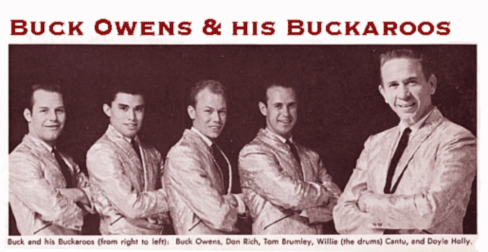
In bands that tour that much, there’s usually two shows happening at the same time. There’s the show the band is doing for the crowd. Then, there’s the show the band is doing for each other. Over time, this playful spirit develops into full-blown comedy bits blended into the setlist. It starts with a joke here or there and, before you know it, you’ve got Buck and the whole band onstage in Beatles wigs doing “Twist and Shout.” Each member of The Buckaroos is given a moment in the spotlight. They work up instrumental numbers to feature one guy or another. Doyle and Don can sing, so they get to take lead on a song, here and there. It’s a one-band variety show and word gets around that Buck Owens concerts are well worth the price of admission.
A few things all start happening at once behind the scenes, here.
The first thing is, Buck starts building what would become his business empire. He’d already formed his own publishing company, way back when he found out Ken Nelson was using Central Songs to double dip. In 1965, he starts a booking agency. Their first acts are mostly from back on the Bakersfield scene: Tommy Collins, Joe and Rose Lee Maphis, Merle Haggard, Wynn Stewart. This makes it very easy to put together killer package tours with these artists. In 1966, Buck Owens buys a radio station in Bakersfield and begins filming a nationally syndicated TV show.

This is not Hee Haw.
The actual name of this show is just The Buck Owens Show but the set is built to look like the outside of a ranch, so everyone calls it The Buck Owens Ranch Show. He hires a female singer, named Kay Adams, presumably so the television show doesn’t look like a sausage party. The best thing about the early days of The Buck Owens Ranch Show is, they don’t know how TV shows are made, so the band is actually playing and singing live. In a few years, they’ll learn from Hee Haw how to pre-record the music and sing live over the backing tracks but that early stuff is straight-up live video from a band doing probably a couple hundred shows a year. Four times a year, they roll through a TV studio to document their excellence. Every person with a favorite band wishes they had a gold mine of footage like this.
Also, in 1966, Buck is approached about playing Carnegie Hall. Now, at first, he’s not into that. New York City’s got to be about the last place on earth where people would like Buck Owens’ music. There’s no reason to go up there, play to an empty room and have all the critics laugh at him in the newspapers. He says he’ll only do it if he has the right to cancel the show in the case of poor ticket sales. Two weeks in advance, the show’s sold out. They decide to make a live album out of it and I’ll tell you all about that, next week, on Cocaine & Rhinestones.

Liner Notes
Excerpted Music
This episode featured excerpts from the following songs, in this order [linked, if available]:
- Buck Owens & His Buckaroos – “Open Up Your Heart” [Amazon / Apple Music]
- Jack Guthrie & His Oklahomans – “Oakie Boogie” [Amazon / Apple Music]
- Hank Williams – “Honky Tonk Blues” [Amazon / Apple Music]
- Wynn Stewart – “I’ve Waited a Lifetime” [Amazon / Apple Music]
- Bud Hobbs & His Trail Herders – “Louisiana Swing” [Amazon / Apple Music]
- Tommy Collins – “You’d Better Not Do That” [Amazon / Apple Music]
- Buck Owens – “Country Polka” [Amazon / Apple Music]
- Joe & Rose Lee Maphis – “Dim Lights, Thick Smoke (And Loud, Loud Music)” [Amazon / Apple Music]
- Terry Fell – “Truck Drivin’ Man” [Amazon / Apple Music]
- Buck Owens – “Down on the Corner of Love” [Amazon / Apple Music]
- Bobby Bare – “Down on the Corner of Love” [Amazon / Apple Music]
- The Farmer Boys – “Yearning, Burning Heart” [Amazon / Apple Music]
- Buck Owens – “There Goes My Love” [Amazon / Apple Music]
- Buck Owens – “Come Back” [Amazon / Apple Music]
- Buck Owens – “Sweet Thing” [Amazon / Apple Music]
- Don Rich – “Cajun Fiddle” [Amazon / Apple Music]
- Buck Owens – “Second Fiddle” [Amazon / Apple Music]
- Don Rich – “I’m Layin’ It on the Line” [Amazon / Apple Music]
- Buck Owens – “Under Your Spell Again” [Amazon / Apple Music]
- Ray Price – “Under Your Spell Again” [Amazon / Apple Music]
- Buck Owens & His Buckaroos – “Sam’s Place” [Amazon / Apple Music]
- Buck Owens & His Buckaroos – “Act Naturally” [Amazon / Apple Music]
- Buck Owens & His Buckaroos – “My Heart Skips a Beat” [Amazon / Apple Music]
- Buck Owens & His Buckaroos – “Together Again” [Amazon / Apple Music]
- Buck Owens & His Buckaroos – “Tiger by the Tail” [Amazon / Apple Music]
- Buck Owens & His Buckaroos – “Before You Go” [Amazon / Apple Music]
Excerpted Video
These video clips were excerpted in this episode. They may be removed from YouTube in the future (for any of a number of reasons) but, for now, here they are:
